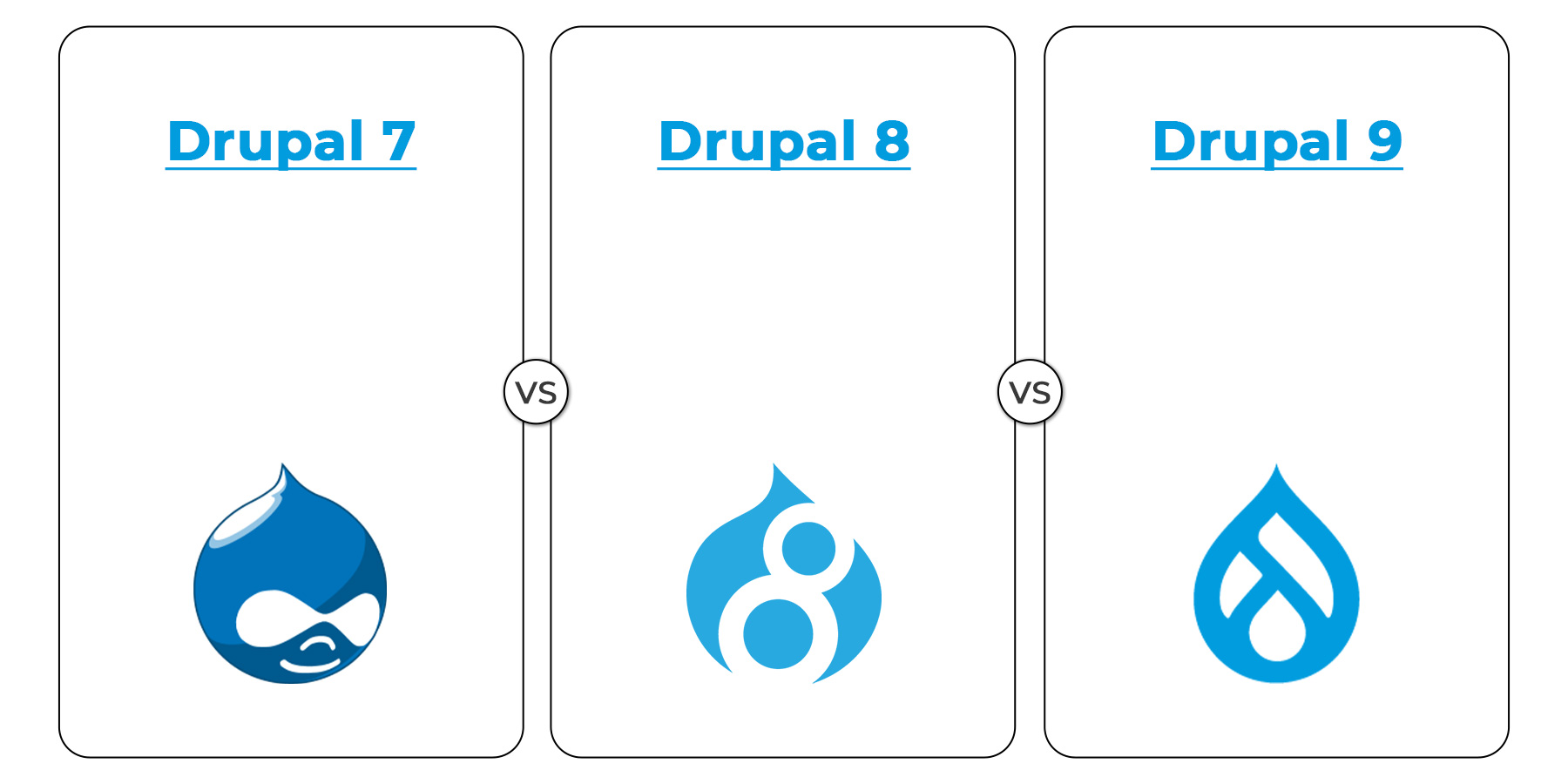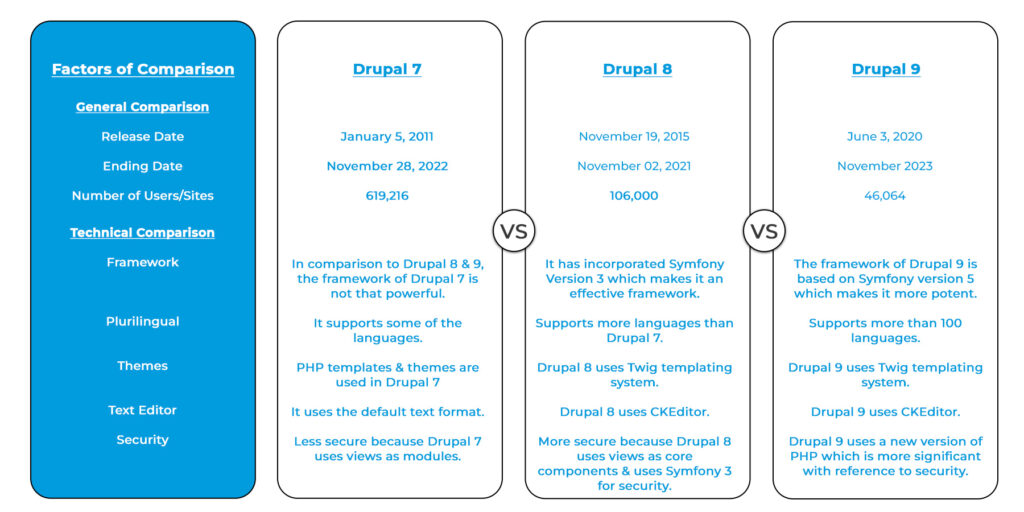Drupal Website Migration – Key Features, Differences, and Process

Introduction
Drupal is a content management system that allows you to create websites with ease. Drupal 7, Drupal 8, and Drupal 9 are the most used versions of this open-source platform. You may be wondering what makes them different from one another, so we’ve compiled features, migration processes & differences you should know to better understand all three.
Drupal lets you build and maintain your own website. There are three popular versions of Drupal: Drupal 7, Drupal 8, and Drupal 9, released in 2010, 2015, and 2018 respectively. In this blog post, we will compare the features of each release, their differences, as well as how to migrate from one version to another.
This blogpost will cover the following information:
- Introduction
- Migrating to a New Version of Drupal
- Background of Drupal
- Evolving Web and Drupal Versions
- Top Drupal 7 Features
- Top Drupal 8 Features
- Top Drupal 9 Features
- Drupal 7 vs. Drupal 8 vs. Drupal 9: Comparing the Differences
- Migration Process – How to Migrate from “Drupal 7 to Drupal 9”, or “Drupal 8 to Drupal 9”?
- Make a Drupal Migration Plan
- Consider time and budget for Drupal Migration
- Consider new features & bug fixes of the Drupal website
- Consider the skillset of Drupal developers
- Planning of Release Window
11. Conclusion
Migrating to a New Version of Drupal
MpireSolutions has helped many clients migrate to a new version of Drupal. There are still some organizations that have not yet made the switch and could be in a difficult position when Drupal 9 becomes more of a requirement than an option. It will become more critical if their site is old and there is less support from the community.
Drupal 8 has already reached its end of life on November 2, 2021 meaning there won’t be any community support or updates of bug fixes post this date.
Background of Drupal
This community-driven open source project was first launched in 2001 by Dries Buytaert as a message board platform for students to discuss topics related to computer science at the University of Antwerp (Belgium). Since then, development on Drupal has continued with the help of a global community of volunteers.
Drupal is an extremely versatile platform that can be used for a wide variety of Drupal websites, from small personal blogs to large-scale enterprise applications. There is no wonder that it’s one of the most popular content management systems on the web!
Evolving Web and Drupal Versions
Drupal has evolved extensively over the years especially with how site users interact with the platform. Drupal 7 has served us well since its release in January 2011. The end-of-life for this version of Drupal was scheduled to be November 2021, but because of the effect COVID-19 had on businesses and budgets, it is now extended until November 28th, 2022.
Drupal 8 was a step between Drupal 7 and Drupal 9. Some people might think that there will be a sudden switch to Drupal 9. However, you have to work hard when changing the custom code from Drupal 7 to Drupal 9 (since Drupal 8 has already reached the end of life on Nov 02, 2021). But in the end, it will be worth it because the new code is better than the old one.
Top Drupal 7 Features
Drupal 7 is a popular choice because it is easy to operate and can be used to develop all types of websites, including social networks, blogs, and microsites. Let’s see some of the top Drupal 7 features:
- Drupal 7 is much easier to use. A number of changes make sure Drupal websites are easier to use and serve today’s audience.
- Drupal 7 can use three different database types, PostgreSQL, SQLite, or MySQL. This means that you can choose which one will work best for your needs. If you want to be able to use more types of databases, then you have the option to install a contributed module that provides extended support engagement.
- The features of this version make it easier to put images in the content. You can choose between different versions for your thumbnails, styles, and previews. With Drupal 7, you can easily make a combination of private and public file handling.
- In the Drupal community, people help each other build things. This is true for Drupal 7 as well as Drupal 8. There are over 800+ contributed modules that have been made by the community, including Pathauto and WYSIWYG.
- Drupal 7 in comparison to previous versions is a different interface that makes it easier to find what you are looking for on the website. There are also features that were not in previous versions of Drupal.
Top Drupal 8 Features
Drupal Core has been rewritten for Drupal 8. This means that many of the problems with speed and stability from Drupal Core have been solved. Drupal 8 provides a number of significant features, let’s see a few of them;
- The most notable feature of its architecture is its responsiveness. You may provide an experience using tablets, phones, or the internet browser.
- Drupal 8’s authoring functionality is well-known. It combines attractiveness, professionalism, and high performance into a single package. You can use Drupal 8 to edit and manage content on your website with greater ease than any previous versions of Drupal. In addition to the WYSIWYG editor, it includes inline and in-context editing on the page level. This makes it easier to modify and manage existing or new site content.
- Drupal 8 has a strong ecosystem of new tools that allows you to embed connected digital technologies, making integration simpler. These features, when used together, become a key marketing consideration. With Drupal 8, you may effortlessly manage web content and digital interactions thanks to its easy connection with other platforms. Drupal 8 includes integration capabilities with a number of established marketing technologies.
- It also allows you to take advantage of a significant amount of creative freedom when it comes to selecting technologies that may be quickly linked with email marketing or marketing automation solutions.
- Drupal 8’s localization or translation is much easier. This platform was made flexible to work with any language, while the user interface was modified to include as many languages as desired.
- Another significant feature of Drupal 8 is the flexibility it provides for content distribution. You may use Drupal as a content management platform to develop and distribute content as a service through any channel, device, or platform at any time. Furthermore, in Drupal 8, you may import material from various sources (channels, applications, and devices).
Top Drupal 9 Features
Consider Drupal 9 to be a more powerful, faster, and easier-to-use version of Drupal. There are many substantial modifications & new feature additions that would necessitate a major upgrade in the future. However, let’s see some of the top Drupal 9 features;
- Drupal 9 is backward compatible, which means it works with its predecessor version, Drupal 8. Unlike D7 and D8, Drupal 9 will be able to utilize modules, site configuration, and data created on Drupal 8.
- Drupal 9 has improved performance and response time by adding a new pillar for responsive images, which displays the optimal mobile image sizes.
- In Drupal 9, Symfony 3 is replaced with Symfony 4 or 5. In addition, the Drupal community launches an upgrade to Twig 2.0. These changes result only in improved performance, a better developer experience, and an enhanced Drupal security team.
- Drupal 9 has dropped support for obsolete code in Drupal 8. This software ensures that deprecated code is no longer supported.
- Drupal 9’s community support is enthusiastically taking advantage of Headless CMS to provide a better user experience through the site’s powerful front-end, which utilizes a JavaScript framework.
Drupal 7 vs. Drupal 8 vs. Drupal 9: Comparing the Differences
Migration Process – How to Migrate from “Drupal 7 to Drupal 9”, or “Drupal 8 to Drupal 9”?
The below information provides some clarity on when you should consider migrating from one Drupal version to an upgraded Drupal version. The decision to migrate should not be taken lightly and should involve careful planning and execution. If you are unsure of where to start, we recommend consulting with an experienced Drupal development agency.
They will be able to help assess your needs and develop a migration plan that will work best for your organization.
Drupal 8 has already reached end-of-life. Drupal 7 is old and needs to be replaced. You should start the migration process from Drupal 7 to Drupal 9 as soon as possible to avoid security implications arising due to end-of-life support for Drupal 8.
Make a Drupal Website Migration Plan
It’s now a question of the scope of work when you start planning for a Drupal 7 to Drupal 9 or Drupal 8 to Drupal 9 move. Do you just want to move your old site’s content to a new, more modern, and more secure platform? Or are you willing to make your site secure & better by looking at data architecture, features, and design? This decision-making process is likely to be influenced by considering the following factors;
- Consider time and budget for Drupal Migration
- Consider new features & bug fixes of the Drupal website
- Consider the skillset of Drupal developers
- Planning of Release Window
1- Consider Time and Budget for Drupal Website Migration
When it comes to Drupal migration, time and money are always factors. Depending on the size of your site, migrating from Drupal versions can take weeks or months. The amount of work required will also depend on how well your old site was built and how to convert outdated code.
More recent Drupal websites that were built using best practices and coding standards will be easier to migrate than older, legacy sites. If you’re not sure whether your site is ready for a migration project, consider having it assessed by an experienced Drupal development firm.
In terms of budget, the cost of migrating from Drupal versions can vary depending on how much work needs to be done. A full rebuild will likely be more expensive than simple migration tasks.
A Drupal agency will be able to recommend an approach based on your needs and finances, as well as provide you with the necessary documentation for moving forward.
2- Consider New Features & Bug Fixes of Drupal Website
Moving from older versions to an updated version like Drupal 9 also means that new features are available which you might want to take advantage of. Features like Media Library, Responsive Images, and Layout Builder all require a Drupal upgrade to utilize them fully.
Migration from older versions can also expose issues with your current Drupal website that were not visible before. There is always a chance that new platforms will behave differently than legacy ones which could impact your users’ experience.
Migration from Drupal 7 to Drupal 9, or Drupal 8 to Drupal 9 can involve a lot of work, as well as cost, time, and money. However, you will be able to take advantage of new features which may help grow your business or improve its online presence. Additionally, there is always the possibility that moving forward with an upgrade could expose issues on your new site not previously visible due to the limitations of older platforms.
This means that a Drupal upgrade could make your existing site better in more ways than one, as long as it is executed correctly and with proper planning.
3- Consider the Skillset of the Drupal Developers
Another thing to consider when planning a Drupal upgrade is your Drupal migration company or Drupal developers’ team. Not all Drupal developers are skilled in the latest Drupal versions, especially if they were not involved in building it from scratch. It’s important that you choose the best Drupal development agency with enough experience and knowledge to handle any potential issues during migration so that there aren’t any setbacks.
Reach out to some expert Drupal developers and discuss your needs with them, or hire an agency for this purpose. If possible, choose a Drupal developer who is Drupal certified in both older and newer versions of Drupal so that you’re guaranteed the best possible outcome. They should be able to provide you with a quote based on the size of your Drupal website and the time needed to perform the migration task.
4- Planning of Release Window
If you’re thinking about upgrading your Drupal version, it’s best to start planning now so that you can be ready when the new Drupal version is released. It’s important to remember that not all Drupal upgrades are created equal – some will require more work than others. Taking the time upfront to plan your Drupal version upgrade will make for a much smoother process in the long run.
Migration of your Drupal website should be executed by an experienced agency, one that has already worked on similar projects and knows how to handle potential issues that may arise during migration. This way you can rest assured knowing that they are taking care of everything while you focus on growing or maintaining your business.
Conclusion
Upgrading your Drupal website is a big decision that should not be taken lightly. There are many basic and important factors to consider before taking the transition. With careful planning and execution, it can be a great way to improve your business’ online presence. If you’re not sure about where to start, reach out to MpireSolutions, an experienced Drupal development agency for a Free Consultation.





